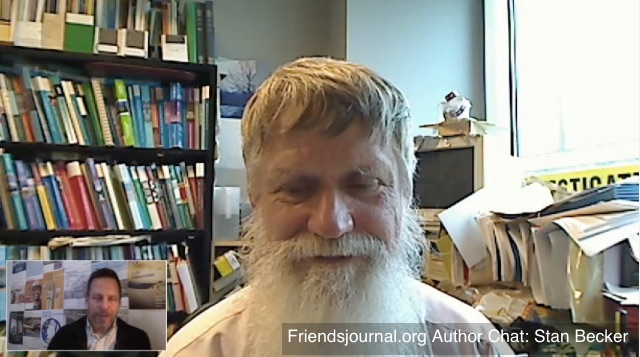Some keep the Sabbath going to church;
I keep it staying at home,
With a bobolink for a chorister,
And an orchard for a dome.
—Emily Dickinson
When I teach First-day school this time of year, I have joy in my heart as I lead the children outside, through the double doors of our meetinghouse and into the crisp morning air. After sitting for the first 15 minutes of silent meeting with adult Friends, we head for another place of worship: the woods. We pass through the meeting’s 250-year-old burial grounds, climb over a stone wall, and follow each other single file along a rough path onto a riparian flood plain thick with old sycamores, spicebush, and multiflora rose. There are spots where tall grasses are matted down by deer who spent the night with their families. We arrive at a small clearing and gather quietly on rustic wooden benches along the banks of Goose Creek, for which our monthly meeting was named in 1745.
A hundred yards away is the spot where the first Quaker meeting for worship was held at Goose Creek. Asa Moore Janney writes in Ye Meeting House Small that here is where his ancestor, Hannah Janney, "began going regularly twice a week to a log in the forest where she set up an altar to her God by spending some time in silent devotion." On our way to the stream, we pass Hannah’s Rock, a small monument under an old walnut tree that memorializes our meeting’s historical and spiritual connection with nature. The plaque reads: "Here on a log in an unbroken forest Hannah Janney, wife of Jacob Janney, worshipped twice weekly in 1736. Erected by Central Subscription at Centennial Celebration 1917."
John Woolman wrote about these woods in his Journal. He reported, "We rode to Goose Creek, being much thro’ the woods. We lodged the first night at a publick-house: the second in the woods, gathering some bushes under an oak, we lay down. Thus lying in the wilderness and looking at the stars, I was led to contemplate on the condition of our first parents, when they were sent forth from the garden. That at this day, it is as necessary for us constantly to attend on the heavenly gift to be qualified to use rightly the good things in this life."
Our First-day school curriculum in the woods is very straightforward. We provide an opportunity to experience unity with nature by focusing on "natural quiet." This is a fairly new term used by natural resource managers to refer to natural ambient sound conditions in wild areas. Occasions for our First-day schoolers to enjoy restorative natural quiet in wild areas are few, even though many live in rural areas. Their lives are heavily scheduled, especially in the fall when free time is usurped by homework and afterschool activities. They are always eager to take to the woods, regardless of what they happen to be wearing. They seem grateful for these stolen First-day mornings along Goose Creek, and have written about their experiences in our monthly newsletters.
At the stream, I lead them through a home-grown version of a spiritual discipline I learned in workshops taught by Chris Ravndal at Pendle Hill. He taught centering prayer, a form of prayer in the contemplative Christian tradition rooted in interior silence. The name was coined by Father Thomas Keating, who believes the simplest way to come to know the living God is to go into one’s center. After I’ve introduced this method of finding inner quiet, I teach them "sound mapping," an environmental education activity to heighten awareness of natural sounds in quiet outdoor settings.
The goal of centering prayer is to open oneself to God’s love by quieting our minds. I tell the children that for me centering prayer helps divert my attention away from busy thoughts that clutter my head and distract me from my intention to get closer to God, particularly when I first sit down in meeting. When I practice it faithfully, I notice I am less irritable during the day, I am more patient with the people I love, and I have less inner turmoil. It deepens my friendship with God. We discuss questions like: What kinds of thoughts do you have in meeting? Are there thoughts that make you feel calm, worried, or sad? Are there thoughts that make you feel quiet inside? What is happening with your body when you have busy or calm thoughts?
I show them that when I do centering prayer, I sit in a quiet place and find a comfortable position. I think of my "secret word" (called a "sacred word" in centering prayer) whenever I have a busy thought. It can be any word that makes me feel quiet inside, like "love," "shalom," or "peace." Eventually, my mind gets quiet and I experience short spaces of time when I feel open to God’s love.
In following weeks, I introduce "sound mapping."
I explain how we can use the sounds in nature to become quiet inside, in the same way we used our "secret word." We each have a clipboard and draw a circle on our paper. We mark X in the middle of the page to represent our position in the woods. Then we become quiet and listen. In these woods, it’s like sitting center stage surrounded by an amphitheater. The most audible sound is always the bubbling and trickling of Goose Creek. There’s also the wind squeaking branches or rustling grasses and dry leaves, the chanting "tea kettle tea" of a Carolina wren, the gurgling "konk-la-reeee" of a red-winged blackbird, the honking of Canada geese, or the buzzing of a bee. There are human-made sounds too: a car door slamming, a jet plane, children giggling. As we hear each sound, we record it on our sound maps, positioning it in physical relationship to our own location at the X. We can record what we hear as sketches, sounds, or names—anything that will help recall the experience later on.
After ten minutes of sound mapping, we share the sounds we recorded and the effect each of them had on us mentally and physically. Was the bird song calming or distracting? What happened in our minds and bodies when the car door slammed and the jet plane flew overhead? What happened when we focused on the trickling stream as opposed to the truck going by? We sound-map for several weeks, until we’ve discussed most of the sounds the woods have to offer. The ultimate goal is to be able to identify at least one natural sound, so that we can recreate its memory in our minds and bodies whenever we want to regain our center. The sound we ultimately choose will serve the same function as a secret word in centering prayer.
Most children engage easily in this activity. They understand the value of quiet. Rufus Jones writes about this in Finding the Trail of Life: "It does not seem necessary to explain Quaker silence to children. They feel what it means. They do not know how to use very long periods of hush, but there is something in short, living, throbbing times of silence which finds the child’s submerged life and steers it to nobler living and holier aspiration." A quiet session with the children at the stream always feels more like a spiritual, unifying activity than anything I do with them in the meetinghouse.
Some of our young Goose Creekers are challenged by this activity and are unable to tap into their inner (and outer) quiet in the woods. In the summer, in particular, the temptation to get wild and barefoot in the stream is pretty intense for all of us, teachers included. So, on warm days, we might be found searching for flat stones to skip on the water, cleaning up the litter from the stream bed, or hunting for crawdads and aquatic macroinvertebrates that indicate various levels of water quality. We’re happy when we find stonefly and caddis fly larvae because they live in clean water and their presence means our stream is still healthy. We provide the results of our stream monitoring to county officials who keep track of the negative effects of residential development along Goose Creek.
Like clean water, natural quiet is a resource that merits protection. It’s as valuable to our well-being as clean air. Our area is losing its natural quiet because Loudoun County, Virginia, in which we are located, is the fastest-growing county in the United States. In the past five years, over 20,000 acres of wild land in our county have been replaced by houses.
Saving natural quiet has special significance in my family because of my late husband, Wesley Henry, who died of cancer in December. With Wes’s passing, our nation lost a fierce advocate for natural quiet. As manager of the wilderness program of the National Park Service, he dedicated his last 15 years to saving the natural soundscapes of wilderness areas in our national parks—the last refuges for visitors seeking spiritual restoration in quiet and solitude. Because of his work, it is possible, for example, for hikers to experience the unbroken silence of the Grand Canyon below the rim, without being bombarded by the shattering noise of helicopters on "flightseeing" tours. In honor of his work, the National Park Service recently established the Wesley Henry National Excellence in Wilderness Stewardship Award.
In the environmental classic, A Sand County Almanac, Aldo Leopold ponders the fate of natural sounds in the future lives of his three sons:
I hope to leave them good health, an education, and possibly even a competence. But what are they going to do with these things if there be . . . no more piping of widgeons and chattering of teal as darkness covers the marshes; no more whistling of swift wings when the morning star pales in the east? And when the dawn-wind stirs through the ancient cottonwoods, and the gray light steals down from the hills over the old river sliding softly past its wide brown sandbars—what if there be no more goose music?
When I find myself despairing about the future of wild lands, I think of First-day school by the stream. It is a source of deep spiritual consolation for me. I believe it is a sacred place that restores those who seek the Light. We have evidence that this was certainly true for Hannah Janney and John Woolman. Our meeting will protect these woods, and many generations of young Friends will continue to hear goose music along Goose Creek, deepening their friendship with God in the process.



